Of Necromancers and Frog Gods: Part Two (The Public Life of Sherlock Holmes)
FROG GOD GAMES
Last November, I did a post on the history of Necromancer Games. I wrapped up with, “And there, our saga of Necromancer Games draws to a close. But our story has most certainly not come to an end.” That’s because Slumbering Tsar would rise from the ashes and a new RPG company would be built on its foundations. Welcome to Part Two: Of Necromancers & Frog Gods.
Waking the Tsar
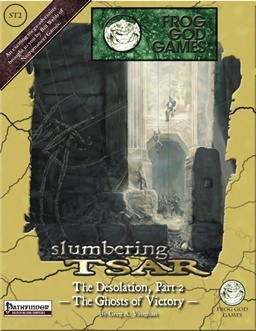 Shortly after Necromancer hung it up, co-founder Bill Webb established Frog God Games just to publish Greg Vaughan’s The Slumbering Tsar as a fourteen-part subscription saga, to be issued as one massive book at the end of the project.
Shortly after Necromancer hung it up, co-founder Bill Webb established Frog God Games just to publish Greg Vaughan’s The Slumbering Tsar as a fourteen-part subscription saga, to be issued as one massive book at the end of the project.
Starting at 7th level, Tsar is divided into three books. If you want to start from 1st level, I suggest using The Wizard’s Amulet and/or The Crucible of Freya, then part of Tomb of Abysthor as a 1st through 6th level lead-in. The Lost City of Barakus is another excellent option, though not as thematically linked. Though it wouldn’t take much to give the villainous Devron a tie-in to Tsar.
Book one, The Desolation, is three installments (parts) dealing with a small settlement in the barren plains. It totals about 125 pages and gives the party a staging area for adventuring towards Tsar. Think of a Necromancer version of The Village of Hommlet – but way nastier. The story of The Army of Light at the very end of part one is worth it alone for me.
Part two includes the Ashen Waste: with such highlights as The Tomb of the Sleeping Knight (not a lot of sleeping going on here) and the burial mound of the barbarian warriors led by Tark. The Chaos Rift, featuring The Sepulcher of the Last Justicar, is even more deadly.
Part Three gets the party to the walls of Tsar, though it might well perish in The Boiling Land or The Dead Fields first. And a sticky situation waits outside the walls…
Book Two, The Temple-City of Orcus, is five chapters, covering about 240 pages. The party gets to explore Tsar proper. Orcus’ citadel seems to be, well, missing, and the party needs to discover what happened. And there are plenty of powerful denizens who plan on keeping them from doing so. This is a very detailed, difficult, city crawl that pours on more back-story about Tsar and the Armies of Light. Love it!
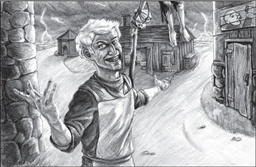
Book Three, The Hidden Citadel, is also five parts and runs about 300 pages. The party discovers Orcus’ plans and, to legitimately use a word that gets thrown around too often, an ‘epic’ dungeon crawl ensues to save the mortal realm. There are a lot of mysteries throughout Tsar and author Vaughan pays them all off. For example, the story behind the Midnight Peddler is pretty cool, though it takes over 400 pages to get it.
For the subscribers, there was a bonus chapter, “Sleeping Dogs,” at the very end. It wasn’t included when The Slumbering Tsar went on sale to the public and I haven’t read it myself. It was (I believe) supposed to tie Tsar into Sword of Air, but plans changed.
With the various appendices, the 7th through 20th level mega-adventure for Pathfinder totals 951 pages! I love it for the history it develops about the war between the Army of Light and Tsar. And it even ties in to the Justicars and The Tomb of Abysthor.
There’s a characteristic of Necromancer Games’ adventures that carried over to Frog God’s as well, and it’s pretty evident in Slumbering Tsar. And it is that the good guys don’t win. This isn’t a huge surprise since the demon prince Orcus (who actually started out as something else, as revealed in Tsar) is the central character in both companies’ mythology. The backstories usually involve really bad things and crushing defeats for the good guys (the story of the Fifty and One is depressing). Of course, the party has a chance to set some things aright in the adventure. But if you’re rooting against the bad guys in a Necromancer/Frog God module, it’s kind of like pulling for the Trojans while reading The Iliad.
Anywhoo… Sales were so successful that Frog God was able go full on as the successor to Necromancer Games. Webb partnered with Matt Finch, creator of the Swords and Wizardry retroclone, and S&W would be a full-fledged product line, in addition to Pathfinder.
Necromancer linked up with Sword & Sorcery at the start and Frog God Games joined forces with Swords & Wizardry almost right out of the gate. Just noticing the similarities in names and timing.
Swords & Wizardy
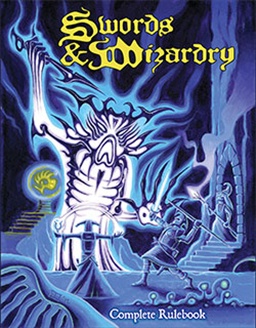 The OGL (Open Gaming License: see Part One of this essay) resulted in whole new competing RPGs, like Mongoose’s Conan: The Roleplaying Game, and Pathfinder, from Paizo. But another group emerged: those who wanted to recreate prior editions of Dungeons and Dragons using the OGL. OSRIC (1st AD&D) and Labyrinth Lord (Tom Moldvay’s Original Basic D&D) are two of the better-known retroclones.
The OGL (Open Gaming License: see Part One of this essay) resulted in whole new competing RPGs, like Mongoose’s Conan: The Roleplaying Game, and Pathfinder, from Paizo. But another group emerged: those who wanted to recreate prior editions of Dungeons and Dragons using the OGL. OSRIC (1st AD&D) and Labyrinth Lord (Tom Moldvay’s Original Basic D&D) are two of the better-known retroclones.
Modular – Fantasy author and Black Gate Managing Editor Howard Andrew Jones, described the retroclone movement as, “A real backlash against the rules-heavy material that bogs down games.” That’s a pretty good description. Rules (and the similar but distinct Options) bloat is the killer of RPGs over time.
In 2008, Matt Finch created Swords & Wizardry, a retroclone based on 1974’s Original D&D. Mythmere Games is his company, which supports not only S&W but also OSRIC (Finch created the first draft of that retroclone) and Labyrinth Lord. Mythmere’s Knockspell is their in-house retro clone magazine.
Finch is Creative Director: Swords & Wizardry, for Frog God. By becoming a founding partner in Frog God, Finch helped give Swords & Wizardry a cornerstone that other retroclones lacked. The same high quality Pathfinder adventures, published to compete with Dungeons and Dragons, are available for Swords and Wizardry. So Rappan Athuk, The Lost City of Barakus and The Black Monastery are all playable with Swords and Wizardry rules, not to mention the One Night Stands, Saturday Night Specials, etc.
The Slumbering Tsar is currently being converted, so that’s on the way! This is unique among retroclones. And, because a stretch goal was reached in The Sword of Air Kickstarter, the S&W Complete Rules book is a free download: forever! That followed up on a 2012 Kickstarter in which over 500 people supported a book reprinting of the Complete Rules.
There are also a few Frog God adventures that are for Swords & Wizardry, but not Pathfinder: The Iron Tomb, Grimmsgate and MCMLXXV (1975). Finch wrote A Quick Primer for Old School Gaming that is a free download from Frog God and helps the retroclone novice to understand the differences from modern gaming. I really like the distinction, ‘heroic, not superheroing.’
With Slumbering Tsar the cornerstone and Swords and Wizardry in place as a systems partner to Pathfinder, Frog God needed to find its niche. An Adventure Path (albeit, a huge one) had gotten the company started: perhaps another one would build on that success. And there’s Erol Otus artwork!
Splinters of Faith (2010-2011)
One of Frog God’s early adventures was a ten-part Adventure Path that could take a character from first to fifteenth level. Akruel was a power-hungry tyrant (as opposed to the generous, giving kind?) who conquered nations. Finally, the forces of good united for the War of Divine Discord. Eventually, on the verge of defeat, he became a Vampire Lord. In spite of this dietary change, his opponents managed to drive a powerful relic, the Scepter of Faiths, through his chest. War over.
Of course, they didn’t realize he wasn’t completely, totally defeated, and the party now has ten modules to re-forge the Scepter and finish the job correctly this time. Aurikus was the dark god that Akruel worshipped. He fell from favor over time, but his worship is on the rise again as the adventure starts. Except he’s got a new name: Orcus! Oh, those Frog Gods…
The party moves from temple to temple all over the place as they attempt to create a new Scepter of Faith and of course, results in a winner-take-all show down.
Splinters of Faith did not make a big splash and was just a brick on the foundation of Slumbering Tsar. At the same time, a themed series of modules was published. It came to a premature halt: but that turned out to just be temporary and it blossomed as a successful The Lost Lands Kickstarter.
The Northlands Saga (2010-2011)
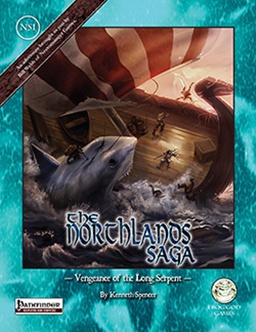 Kenneth Spencer proposed a Viking expansion book, Fury of the Northmen, to Greg Vaughan of the recently established Frog God Games. That initial proposal became four modules: Vengeance of the Long Serpent, Beyond the Wailing Mountains, The Death Curse of Sven Oakenfist and Blood on the Snow.
Kenneth Spencer proposed a Viking expansion book, Fury of the Northmen, to Greg Vaughan of the recently established Frog God Games. That initial proposal became four modules: Vengeance of the Long Serpent, Beyond the Wailing Mountains, The Death Curse of Sven Oakenfist and Blood on the Snow.
Four more modules were planned, but Spencer moved on to other projects and Vaughan was busy with other projects, including development of Frog God’s upcoming campaign world, The Lost Lands.
I wrote a rather lengthy review (spoilers marked) for all four modules. The first two had more of an American Eskimo feel, while the latter two were all axe-wielding, long ship-rowing, Viking adventures.
In 2014, Greg Vaughan turned his attention back to the Northlands and it was a successful Kickstarter, with over 500 backers pledging over $70,000. It is all the Viking campaign material you will EVER need.
For me, Judges Guild screams, ‘First Edition’ (well, at least AD&D). When my buddy and I rode our bikes to The Drowsy Dragon or Hobby Town, he would get a shiny TSR module (I still remember the day he bought Castle Amber) and I would get a color-bled Judges Guild adventure; like Glory Hole Dwarven Mine.
Frog God turned to Jon Stater for some old school hex crawling in a series that brought back the days of the Wilderlands (of both High Fantasy and the Magic Realm!).
Modular – After TSR, I think Judges Guild is the most important company in Dungeons and Dragons history. They were the only real alternative to TSR for several years; with the Wilderlands, they provided an alternative to Greyhawk; and they also supported Traveller in its early days. I suggest reading Shannon Appelcline’s excellent Designers and Dragons (Volume 1) and Judges Guild’s Bob & Bill: A Cautionary Tale to learn about the first third party publisher (so who the heck are the second party publishers, anyways?).
HexCrawl Chronicles (2010-2012)
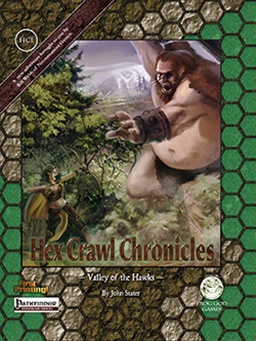 There are seven entries in this series that harkens back to the days of Judges Guild’s Wilderlands books. Back in the early days of D&D, players moved around hexes on a map, encountering all kinds of people, monsters, settlements, dungeons, etc. It’s the true definition of a sandbox adventure.
There are seven entries in this series that harkens back to the days of Judges Guild’s Wilderlands books. Back in the early days of D&D, players moved around hexes on a map, encountering all kinds of people, monsters, settlements, dungeons, etc. It’s the true definition of a sandbox adventure.
Whatever storyline might exist was created by the GM (DM, Judge, Referee, whatever). A short description was included for many, but not all, of the hexes. Here’s an example of Hex 0529 from Hex Crawl Chronicles HC5 – The Pirate Coast:
An ancient abandoned prison stands here, dominating the landscape. The prison was constructed by the stone giants, and thus sized for giants. It is constructed of gray stone and has a single entrance blocked by two thick portcullises of steel. The prison consists of a tall, round building of four stories (20 ft. tall each) lined with cages. There is a central guard tower in the middle of this larger tower and the floor of the large tower is actually a treadmill, meant to work the energy out of prisoners. The prison is now roamed by a few random jellies and giant rats. The only sentient inhabitant is the spectre of a stone giant murderer named Verc. Turning the treadmill requires 36 people, twelve horses or six oxen. It does nothing useful.
It then gives Verc’s CR, HP and XP values and references the Pathfinder Bestiary for ‘Spectre.’
That’s it. Some hex entries are more developed and others are bare bones. In this particular module, about 45 of the 60 pages consist of hex entries. So, there are a LOT of areas to run into something.
The Hex Crawl Chronicles can serve the additional purpose of being adventure hook generators. There are dozens of ideas in each that you can simply drop into your current campaign and use. In fact, they’re fun just to read. These are part of John Stater’s ‘Land of Nod’ and will not be included in The Lost Lands.
But the HCC entries are a return to the days when the GM made up the adventures. There weren’t adventure paths and metaplots (the bad guy in Dave Arneson’s Blackmoor was an alien running a barony). The supplement gives the GM some ideas and backup info and turns them loose.
One Night Stands & Saturday Night Specials (2010-2011)
To describe the thoughts behind these two series of modules, I don’t think I can do much better than to borrow directly from Frog God’s website:
Remember when the world was a sandbox and you just inserted modules into your campaign whenever and wherever you wanted to? Remember when companies like Judges Guild and TSR produced short standalone modules not tied to any setting or campaign? Remember when they cost 5 bucks (ok, we can’t do print books for 5 bucks anymore, but we can do that for the pdfs)?
Remember when you directed the action independently of what the “world” rules said was there? We do, and in response we decided to fill the gap with our One Night Stands and Saturday Night Specials series.
These modules are designed to be played over the course of 1–2 nights. Each is a sandbox style short adventure (One Night Stands) or a short dungeon crawl (Saturday Night Specials).
Frog God Games knows that in this day and age, sometimes a gamemaster just needs a short trek to take his players on, or to fill those regular gaps and interludes in his campaign. Sometimes its just fun to enter a dungeon and kill things for a night! Old school feel is the trademark of these product lines. Look for easy deaths and tough puzzles. Frog God Games is not made for rookie players.
I have a few of these modules and I suggest buying a pdf and checking out the feel.
FGG Modules (2010—2011)
Frog God was also putting out a few stand-alone modules, such as Fane of the Fallen, Strange Bedfellows and Ursined, Sealed and Delivered.
Ursined, Sealed & Delivered (2010)
This new module was written by Dennis Sustare, creator of the original Druid class. It was actually written for Sword & Wizardry and converted to Pathfinder.
The Black Monastery (2011)
Webb put out The Black Monastery, which was a homemade dungeon created by a friend and one of the first adventures he ever played. It is very much in the mold of the classic Tegel Manor. There’s a background story but no over-arching plot. The party just goes in to kill as many things as it can. Sometimes, that’s the kind of fun you’re looking for.
Having said that, there are two towers in the Monastery; each of which has a BBEG dwelling within. And a creative GM can certainly fashion a compelling quest around one or both of them. There are other elements in the module that you can do the same with. But by design, it’s set up for your party to go on in and smack the heck out of everything you see. And if you are a fan of Tegel Manor, you’ll absolutely love the map for this one.
Tome of Horrors (2011, 2013)
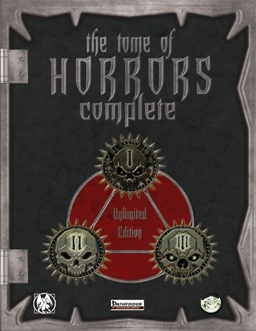 Webb and Clark Peterson had produced the first Creatures Collection for Sword & Sorcery Studios during their early days as Necromancer Games. That was really a White Wolf product and did not become a part of Necromancer and Frog God’s rights.
Webb and Clark Peterson had produced the first Creatures Collection for Sword & Sorcery Studios during their early days as Necromancer Games. That was really a White Wolf product and did not become a part of Necromancer and Frog God’s rights.
Now, I really like to read monster manuals. And while Sword and Sorcery would produce two more Creature Collections (plus a Scarred Lands revision of I), Necromancer wasn’t going to leave that market untapped. Tome of Horrors I included a slew of monsters from 1st Edition but left out of the new 3rd Edition. Plus, a whole bunch of new ones. Totaling over 400 beasties, it was a hit for Necromancer. The Tome of Horrors II added about 250 more monsters and was for version 3.5. Tome of Horrors III tossed in another 200-ish, also for 3.5. The first volume was revised for 3.5 as well.
Necromancer had really set a standard for bestiaries. One that Frog God decided to build on. They compiled all three of the Tome of Horror volumes into a MASSIVE, 800 page monster collection for Pathfinder and Swords and Wizardry. But that wasn’t enough for Tsathogga.
Tome of Horrors IV (the first of the series in color) added another 300 pages in 2013. That’s about 1,100 pages of monster goodness…. err, badness, from Frog God. Tome of Horrors Complete is one of my favorite books for Pathfinder. Add in the five official Pathfinder Bestiaries and it’s monster heaven!
GM Aids
Some products cross categories, so I’m just trying to address them in a sensible fashion: not the only one. In Part One, I talked about the Glades of Death (forest) supplement. Necromancer also produced a pirate themed supplement, Dead Man’s Chest, which Frog God Pathfinderized as part of the Razor Coast Kickstarter. They have continued the line with Dunes of Desolation (desert) and Fields of Blood (savannah). Both were written by Tom Knauss.
Unusual Suspects offered up sixty NPCs for use. The Tome of Adventure Design is primarily a collection of random generation tables for help in preparing an adventure. Bill Webb’s Book of Dirty Tricks was a homemade collection of things the GM could do when they wanted to have a little fun with the party and was originally a Kickstarter bonus. There are many more you can check out at the Frog God website.
KICKSTARTING TO SUCCESS
Rappan Athuk
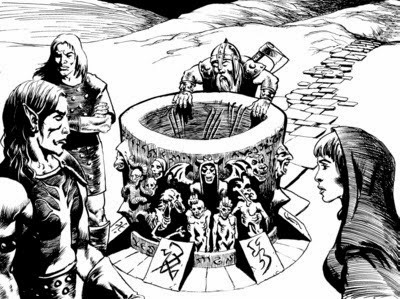
In 2012, Frog God set its feet on the path to continued success. Rappan Athuk (mentioned here in Post One) had been updated to version 3.5 with Rappan Athuk Reloaded. When Frog God offered the chance to back an update for Pathfinder and Swords and Wizardry, over ONE THOUSAND people jumped on it. A $25,000 goal brought in $246,000!
Nearly seven hundred pages long, old school Tomb of Horrors fans now had a far bigger, harder dungeon crawl available for Pathfinder and S&W. Rappan Athuk’s Kickstarter showed that there was a significant fan base for modern incarnations of Necromancer’s modules. Meanwhile, Webb had a plan in place and Frog God bought out the remaining rights to Necromancer Games’ products. This would be a huge move.
Somehow, I missed out on the Rappan Athuk Kickstarter: I think I was taking an RPG break. But I got on board with the next one and have continued forward. If anyone doubted Frog God’s ability to pull off a massive project (and there was no reason at all to do so after Slumbering Tsar and Rappan Athuk), successfully Kickstarting Nicholas Logue’s ill-fated and scandalous Razor Coast certainly took care of that.
Razor Coast (2013)
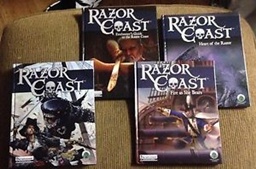 As with several other of the Kickstarters, I’ll talk more about this one in The Lost Lands post (if I ever get that one written) And I may well do an entire post on just this one as well. Nick Logue created Sinister Adventures to publish a massive nautical adventure, The Razor Coast. A successful game designer, Logue was in well over his head as a businessman, nothing was produced, many people who pre-funded it did not get a refund and Logue moved out of the continental United States. These are facts, whatever the reasons and extenuating circumstances may be. They are not, however, the end of the story.
As with several other of the Kickstarters, I’ll talk more about this one in The Lost Lands post (if I ever get that one written) And I may well do an entire post on just this one as well. Nick Logue created Sinister Adventures to publish a massive nautical adventure, The Razor Coast. A successful game designer, Logue was in well over his head as a businessman, nothing was produced, many people who pre-funded it did not get a refund and Logue moved out of the continental United States. These are facts, whatever the reasons and extenuating circumstances may be. They are not, however, the end of the story.
Lou Agresta decided to salvage Razor Coast, refunded money to everyone who could prove they paid and had not already been compensated, and partnered with Frog God. Frankly, I’m still a bit stunned at this and admire Lou for what he did.
709 backers raised over $120,000 and Frog God delivered another massive (546 pages) adventure that stands alongside the Freeport series for pirate adventuring. They also produced Heart of the Razor, which included four additional adventures. And a nifty gazetteer/player’s guide. And…you get the idea. Razor Coast is a mini-sandbox campaign in the classic Necromancer style.
TO THE STONEHEART VALLEY
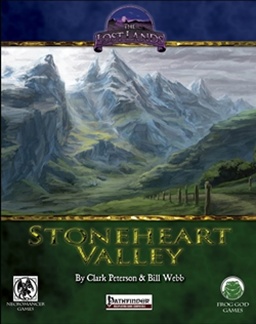 In an author’s note in The Slumbering Tsar, Greg Vaughan said, “While Frog God Games may someday perhaps stitch its adventures together into a coherent campaign world for some future product…” It was time for just that.
In an author’s note in The Slumbering Tsar, Greg Vaughan said, “While Frog God Games may someday perhaps stitch its adventures together into a coherent campaign world for some future product…” It was time for just that.
I talked about The Wizard’s Amulet and The Crucible of Freya in Part One. Those two made natural lead ins to The Tomb of Abysthor. Fan favorites but hard to find, Frog God Pathfinderized (and Sword and Wizardried) all three of them with minimal changes and released The Lost Lands: Stoneheart Valley.
It was the initial installment in a series for The Lost Lands: a coherent campaign world that will include nearly everything produced by Necromancer and Frog God Games. There are a few exceptions, such as Rob Kuntz’s Mayene modules, the Judges Guild products and the previously mentioned Hex Crawl Chronicles, but almost everything else is in there.
Syd Field, in his classic book, Screenplay, wrote about the structure of the screenplay being the spine that the rest of the script hangs on. The Stoneheart Valley is the spine of The Lost Lands. Or the foundation that the rest is built on.
Tomb of Abysthor (2013)
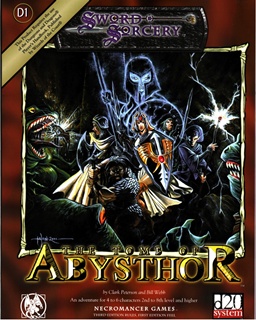
I really like Wizards’ Forge of Fury, but Tomb is my favorite 3rd Edition module. The once-sacred burial halls of the god Thyr and his sister goddess Muir have been taken over by evil. And the last high priest of Thyr disappeared on a quest into the Tombs. There are all kinds of bad things going on in this mega dungeon (that Orcus guy just doesn’t give it a rest). There’s much to do and it’s easy to tie in to a Slumbering Tsar storyline: plus it’s got its own specific quest to accomplish. Among my many ideas for a novel, a trilogy incorporating The Crucible of Freya and Tomb is on the list. It’s a great adventure.
Vaughan said in the intro to Stoneheart Valley: “We took the Stoneheart Mountains to be true to their name and made them a geographic lynchpin—the range is huge and is considered the “backbone” of the world. Everything spreads out from there with Bard’s Gate and the Stoneheart Valley holding a central location.”
And with the recently successfully kickstarted Bard’s Gate and with The Mountains of Madness coming soon, that area is central to the campaign world. Not only is Tomb of Abyshtor my favorite 3rd Edition module it is also a favorite of several Necromancer and Frog God staffers. The history ties into Rappan Athuk’s (and naturally, Slumbering Tsar) and is a multi-story dungeon crawl that a GM can take in several directions. One of mine of choice is to re-establish the Justicars (a Prestige Class with an in-world history).
BACK TO KICKSTARTING
W.D.B. Kenower’s The Lost City of Barakus is a mini-campaign that was one of Necromancer’s most popular modules. And when a Kickstarter came to convert it to Pathfinder and Swords and Wizardry as part of The Lost Lands, 991 backers signed on and it was delivered in 2014. The original was revised through stretch goals that were met, including a new level and several wilderness encounters. There’s also a Player’s Guide. This is another of my favorites and can be used with a wide range of other campaigns. In fact, this gets my recommendation to introduce players to Swords & Wizardry.
This was immediately followed by Necromancer’s most famous talked-about but never-delivered products. Bill Webb first mentioned Sword of Air all the way back in The Crucible of Freya. (Bard’s Gate as well: at least that one didn’t take as long to publish) For him, it was “the adventure” of his home campaign (that campaign is what The Lost Lands is based on). And, using all his dusty old notebooks and scribbled maps, Sword of Air was finally going to come together.
It did and came in at over 500 pages of a sandbox mini-campaign in 2014. There’s most definitely an epic quest to find a sword and get rid of a huge evil: of course, with a Necromancer twist. But there are a bunch of side-adventures for the characters that let them choose their path.
And up right away that same year was a Kickstarter for Quests of Doom, which contained eighteen adventures! Six were reprints: three each from Necromancer’s Demons and Devils and Vampires and Liches. Which left a dozen new ones. This book doesn’t carry The Lost Lands logo, but within each adventure there’s a paragraph on where to place it in the campaign world, so it fits in seamlessly. The Sword of Karith history in The Pit of Despair is more great Justicar stuff.
Modular – Judges Guild got Kickstarter funding for a Pathfinder update of their famous City State of the Invincible Overlord in April of 2014. When (if) it is completed, it will be well over one year late, moving towards two. Since that April date, Frog God has delivered five Kickstarted products and successfully funded several more. All delivered in a timely fashion. Frog God’s quality and quantity of output for their The Lost Lands campaign has been exemplary.
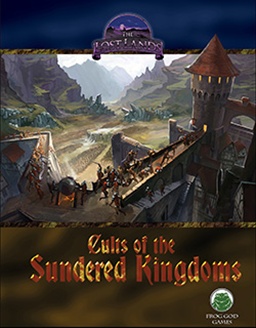 Because Greg Vaughan isn’t allowed ‘down time,’ Cults of the Sundered Kingdoms hit Kickstarter and was backed by 499 folks. This one was a little different. It contained the first Lost Lands Gazetteer, which gave a lot of info on that part of the Sinnar Coast region. It also took three Necromancer modules: Morrick Mansion, Aberrations and The Crystal Skull, and added linking adventures that turned it into a The Lost Lands adventure path. I love the Gazetteer approach, fleshing out the world and giving hints at what can be expected in the forthcoming full-blown campaign setting box set!
Because Greg Vaughan isn’t allowed ‘down time,’ Cults of the Sundered Kingdoms hit Kickstarter and was backed by 499 folks. This one was a little different. It contained the first Lost Lands Gazetteer, which gave a lot of info on that part of the Sinnar Coast region. It also took three Necromancer modules: Morrick Mansion, Aberrations and The Crystal Skull, and added linking adventures that turned it into a The Lost Lands adventure path. I love the Gazetteer approach, fleshing out the world and giving hints at what can be expected in the forthcoming full-blown campaign setting box set!
Remember The Northlands Saga from earlier in this essay? Well, it was back with a vengeance in 2015. 442 backers received a 1st to 20th level adventure path and campaign guide set in the frozen tundra. I had signed on for the six additional adventures they offered as part of the Kickstarter, so I’ve got enough Viking adventures to last a long, long time.
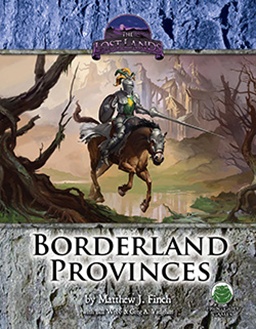 And right away in the Fall of 2015, another Kickstarter rolled out: The Borderland Provinces. Over 500 people backed this as Frog God just Kickstarted one successful project after another. This campaign book covers the region that includes Bard’s Gate and Rappan Athuk. And options within the Kickstarter included an Adventure Book, a Player’s Guide and a Player’s Gazetteer. So, this is really a true sandbox.
And right away in the Fall of 2015, another Kickstarter rolled out: The Borderland Provinces. Over 500 people backed this as Frog God just Kickstarted one successful project after another. This campaign book covers the region that includes Bard’s Gate and Rappan Athuk. And options within the Kickstarter included an Adventure Book, a Player’s Guide and a Player’s Gazetteer. So, this is really a true sandbox.
Richard Pett’s creepy The Blight went live shortly before Thanksgiving and funded at $121,301 (on a $75,000 goal), from 795 backers. Think of a clockwork-themed world, but driven by necromancy instead. It’s going to be pretty, err, unique. The book will be half campaign guide, half adventure path.
And just wrapping up this past Friday was a Kickstarter for a mega guidebook for Bard’s Gate. Showing there’s no Kickstarter fatigue for Frog God fans, 726 backers signed on. I have the original 3rd Edition (which you know of from my prior post) and always liked the flavor. Now, at over 500 pages, it’s got the meat to be the backbone of the entire The Lost Lands campaign! I can’t wait to get this one.
While there are a lot of folks who supported both, that’s over 1,500 backers for two projects this year!
I can’t do justice to these products here, which is why I hope to do an entirely separate post for The Lost Lands. But there is no doubt that Frog God Games, which was looking for direction after The Slumbering Tsar, has found its center with this campaign world.
5th EDITION
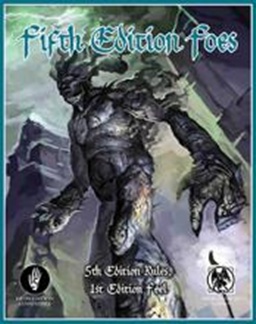 4th Edition was the death knell for Necromancer Games (and nearly for Dungeons and Dragons, for that matter). But Frog God, supporting Pathfinder and Swords & Wizardry from the outset, is now putting out 5th Edition content.
4th Edition was the death knell for Necromancer Games (and nearly for Dungeons and Dragons, for that matter). But Frog God, supporting Pathfinder and Swords & Wizardry from the outset, is now putting out 5th Edition content.
They have produced several supplements for the new 5th Edition of D&D: all with the Necromancer logo and “5th edition rules, 1st edition feel” slogan on them! Quests of Doom (Volume I and Volume II), Quests of Doom 2, Quests of Doom 3, Fifth Edition Foes and the Book of Lost Spells provide adventures, monsters and magic and the old standby, The Wizards Amulet, was converted to 5th Edition.
And the Borderlands Provinces Kickstarter was the first from Frog God to be for all three game systems they support. Quests of Doom 4 is planned: presumably for 5th Edition (but hopefully not just!).
I haven’t looked into 5th Edition at all, but friends who would know say that it is a return to pre-3rd Edition D&Ding and are impressed with it. Unlike 4th, it looks like 5th Edition will be around for a while. It certainly appears that Frog God is in for the long haul.
IT’S A NECROMANTIC FROG GOD
People who played Necromancer modules knew what they were getting. And Frog God Games is not for the high fantasy type of fan. Both companies were about down and dirty adventures that were bleak for the good guys.
Matt Finch posted an update for the Borderland Provinces Kickstarter that compared it to film noir. Frog God is the current incarnation of Bill Webb’s vision from co-founding Necromancer Games. And Finch’s description conveys how Frog God approaches their campaign world, which is built on Necromancer’s foundation:
So, what do people mean when they talk about “Dark Medieval” as a way of describing the Lost Lands? At a surface glance, the world looks fairly traditional: there are elves, there are halflings, there are wizards… what’s the big deal? How is that “dark?”
Basically, we’re the “film noir” version of escapist fantasy, in contrast to Tolkien’s epic and folkloric approach to the same genre. Our adventures tend to have lots of horrific elements underlying the apparent reality, which is why you’ll often see us saying, “All is not as it seems” when we’re talking about the Lands. Where the Forgotten Realms have a strong tendency toward high fantasy and heroism, our world is a bit… well… ickier.
One of the strong themes of the campaign is that beneath the civilized veneer of things, there is actually a seething mass of rot, evil, heresy, and supernatural threat. Again, “all is not as it seems.” The Borderland Provinces campaign book, as a supplement, has more focus on the actual veneer than an adventure book.
What does the “normal” world look like when I’m not in one of these dungeons? So there is a lot of material about culture, history, trade, and government that would be a bit boring if it weren’t for the fact that it’s written in a way to best drive the game master’s creativity about what kinds of adventures arise from that context. And of course, it also reveals a lot of information about what’s beneath that veneer, a peek into the aforementioned seething mass of rot, evil, heresy, and supernatural threat.
Webb had a great quote in the comments for one of the Kickstarters:
“I’ll honestly say that the goal is to take the breadth of what my dear friend Bob Bledsaw did with Wilderlands, add the detail level of Arduin, and stuff it with adventures like FR or Greyhawk.”
If you came to Dungeons and Dragons before 3rd Edition, you should know those references. And it should tell you what kind of wide-open, fun adventuring ‘The Lost Lands’ is going to provide.
There is more I could add, but I might never actually finish this post, which was originally intended to be in December of 2015. So, that brings our look at Necromancer and Frog God Games to its completion.
But as Lieutenant Columbo used to say, “Just one more thing.”
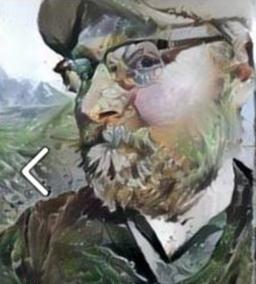 Chuck Wright was a fan who ended up designing some covers for Necromancer (I love Lost City of Barakus). When Bill Webb and Greg Vaughan hatched their plan to get The Slumbering Tsar fully completed and produced, they turned to Chuck for the layout. And in a monster five-day workweek, Wright did just that and he’s been a key part of Frog God since.
Chuck Wright was a fan who ended up designing some covers for Necromancer (I love Lost City of Barakus). When Bill Webb and Greg Vaughan hatched their plan to get The Slumbering Tsar fully completed and produced, they turned to Chuck for the layout. And in a monster five-day workweek, Wright did just that and he’s been a key part of Frog God since.
Wright, a veteran, recently had one of his legs amputated below the knee. In response, Webb and Matt Finch produced Chuck’s Dragons. Available for all three FGG-supported systems, it’s got dragons and their lairs, ready for plugging into your sessions. And all profits from this one go to benefit Wright, who will be doing layout and design before you know it. So, think about making a purchase.
If I get another RPG burst, a post on one or all of The Lost Lands might pop up here at Black Gate. But I think this two-parter has been about 9,000 words, and that’s the equivalent of nine regular columns. So, we’ll see. Plus, I still really want to write a post on the Dungeon! Board game, which goes back to the original Blackmoor campaign!
Other Game/RPG-related posts I’ve done here at Black Gate:
Necromancer Games
The Lost Lands for Pathfinder
The Northlands Saga – Complete
The Warlords of the Accordlands
Judges Guild Premium Editions
Gary Gygax’s Role Playing Mastery
Munchkin!
Runebound
Runebound – The Sands of Al-Kalim
Runebound – The Mists of Zangara
Dungeons and Dragons Adventure Game System
Temple of Elemental Evil Play Through (D&D Adventure Game System)
Sherlock Holmes: Consulting Detective
221B Baker Street: The Master Detective Game
Conan: Age of Exiles
You can read Bob Byrne’s ‘The Public Life of Sherlock Holmes’ column here at Black Gate every Monday morning.
He founded www.SolarPons.com, the only website dedicated to the ‘Sherlock Holmes of Praed Street’ and blogs about Holmes and other mystery matters at Almost Holmes.
His “The Adventure of the Parson’s Son” is included in the largest collection of new Sherlock Holmes stories ever published. Suprisingly, they even let him back in for Volume IV!
And he’s been gaming since the mid-seventies. Earlier if you count Candy Land and Chutes and Ladders.
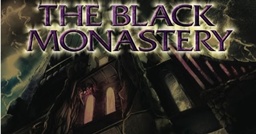
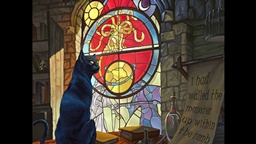
I’m a big fan of Necromancer Games and Frog God Games products. I like an awful lot of what Finch and Vaughan write, although I’ve yet to take a plunge into Tsar. I’ve tried several times to interest my group into some really good epic dungeon crawls, and they just don’t like them very much.
I can’t tell you how often I’ve contemplated picking up Razor Coast or, more recently, The Northlands stuff, but again there’s lack of interest from my players in pirates or vikings.
But I do have a number of the Saturday Night Specials, various standalones, and the Hex Crawl Chronicles, three of which I number among the finest role-playing products I’ve ever read. I hope to use one, soon, (The Winter Woods) as a basis for a campaign. For the curious, my favorites are HCC: 2, 3, and 4. I wrote a glowing review of them over here: http://www.howardandrewjones.com/reviews/hex-crawl-chronicles
Howard – Tsar is just so massive and so deadly I have a hard time imagining actually trying to play through most (not necessarily all) of it. But man, just reading it is almost like an epic fantasy novel.
Due to cost and space, I buy PDF versions these days. But I would love to have a shelf full of these The Lost Lands kickstarters. I’m excited to see the recreated Bard’s Gate, which just funded last week.
Wow,
Many thac0s to you for this wondrously massive RPG post! I can’t wait to spend some (more) quality time poring over it 🙂
Keep rolling for glory,
Anthony
Glad you like it, Anthony. I don’t get to play these days, but I still like to read some RPG stuff when time allows. And with Frog God, I get what I like about Pathfinder, but also what I used to like with Necromancer’s 3rd Edition stuff.
They really do story telling well.
Like you, I don’t get to play much anymore either :-/
…I’m getting the impression that the level of RPG pick-up gaming at “Ye Ol’ Local Game Shoppe” appears to have dropped considerably of late.
I “feel” like I’d still like to game, but there are so many constraints that just didn’t exist when I was a teen. I may try online, Roll20 or the like… Quality materials as you’ve outlined here would seem to make continued “pen & paper” gaming still worth it 🙂
It’s been a couple years now, but I did play in a few online games at the Pathfinder website (even running one for awhile). I enjoyed it, and it definitely fit my time schedule better than trying to play in person. It wasn’t live, but everybody checked in a time or two each day and the games moved along.
I tried to get a lunch game going here at the office, but it just didn’t prove workable. Time constraints are tough to overcome to ‘gather together’ regularly. Home or work.
[…] So, I finally finished my history of Frog God. When coupled with that first post, it’s an almost 10,000 word look one of the major players in the third party publisher field. If you are familiar with either company or there’s D&D in your past (or present), you might want to check these posts out. […]
I recently took a deep delve (but not a dwarven one: that’s a little Len Lakofka for you) into Swords & Wizardry, looking at it in comparison to Pathfinder.
If you have any interest in the old school style of RPGing, head on over.
https://www.blackgate.com/2016/09/08/why-i-went-old-school-or-swords-wizardry-vs-pathfinder/
Bard’s Gate is a FANTASTIC city setting and a superb addition to The Lost Lands.